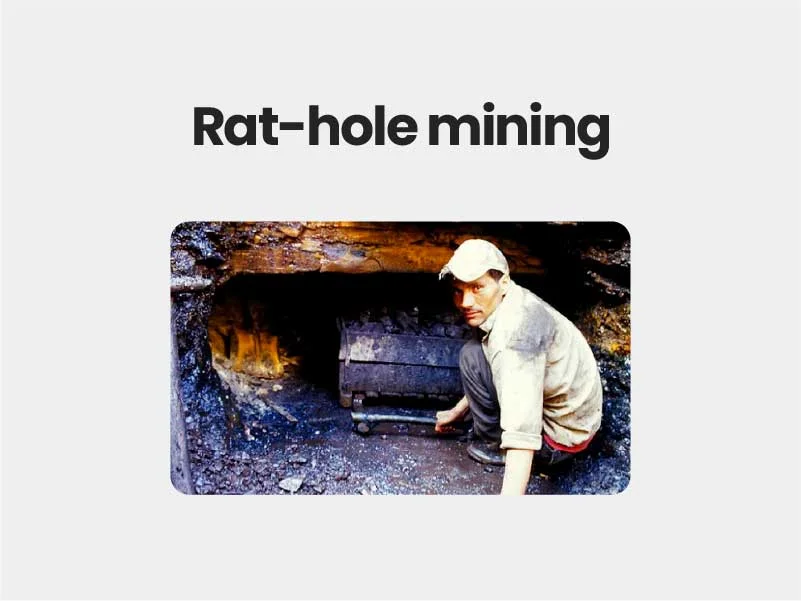
Rat hole mining
It is a primitive and hazardous method of mining for coal, with tunnels that are only 3-4 feet in diameter (hence, rat-hole), leading to pits ranging from 5-100 sq. mt deep.
- There are two types of rat-holes: when dug into the ground these are vertical shafts leading to the mines where horizontal tunnels are dug; the second type is where horizontal holes are dug directly in the hillsides to reach coal seams (bed of coal).
- The coal is taken out manually, loaded into a bucket or a wheelbarrow and dumped on a nearby un-mined area. From here, it is carried to larger coal dumps near highways for trade and transportation.
- Rat hole mining cheaper than other conventional mining methods and also hilly geography necessitate such mining method.
Coal reserves:
- Coal reserves are primarily found in the Eastern India in states of Telangana, Madhya Pradesh, Maharashtra, Jharkhand, Chhattisgarh, West Bengal and predominantly in North-East regions like Assam and Meghalaya.
- Despite the presence of coal reserves, commercial mining is not practiced in the North-Eastern regions because of terrain’s unsuitability as well as nature of coal deposits.
- Open mining cannot be practiced due to the added difficulties. Further, the coal found in North-East contains lots of sulfur.
- This overall reduces the energy efficiency and therefore this type of coal is categorized as bad quality of coal.
Impact of Rat Hole Mining :
- 15 workers were trapped in a 320-350 feet-deep coal mine in the East Jaintia Hills district of Meghalaya after it was flooded by waters of the nearby Lytein river.
- Rescue operations led by the National Disaster Response Force and the Indian Navy are on to locate the trapped workers.
- The recent mishap is one of several such accidents that have taken place over the past few years, leading to the death of workers.
- Water from rivers and streams in the mining area has become unfit for drinking and irrigation, and is toxic to plants and animals.
- A study by the North-Eastern Hill University, Shillong, says the Kopili river has turned acidic due to the discharge of acidic water from mines and the leaching of heavy metals.
- Layers of rock above the coal removed during mining contain traces of iron, manganese and aluminium that get dissolved from mining sites through the acid run-off or are washed into streams as sediment.
- due to small size of tunnel, there is incidences of employing children as worker; no social security for migrants workers from nearby states.
- Cultural concern: rampant illegal mining destroying natural caves in jaintia hills.
Rat-hole mining is illegal:
- The National Green Tribunal banned rat-hole mining in Meghalaya in 2014 on a petition that said acidic discharge from the mines was polluting the Kopili river.
- But the practice continues unabated.
- Meghalaya Mines and Mineral Policy, 2012 does not address rat hole mining issue
- The government of Meghalaya controls only 5% land rest either community or privately owned which undermines effective regulations
- Misuse of 6th Schedule of Constitution which provides tribal communities right over -land and use of its resources- by illegal miners and local councils
Way forward:
- Mining has provided jobs to local people. Following the ban, there are demands for rehabilitation or alternative employment.
- Effective implementation of 6th schedule
- Diversifying livelihood opportunities
- Stringent implementation of the Mines and Minerals (Development and Regulation) Act which prohibits operation of illegal mining under state accountability
Enroll today with the best civils service academy and take your first step towards yours Civils out journey.
Feel free to reach to us for any inquiries, collaborations, or support. We’re here to help

